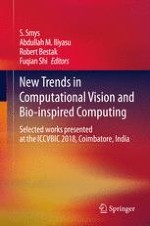2020 | OriginalPaper | Chapter
Assistive Technology Evolving as Intelligent System
Authors : Amlan Basu, Lykourgos Petropoulakis, Gaetano Di Caterina, John Soraghan
Published in: New Trends in Computational Vision and Bio-inspired Computing
Publisher: Springer International Publishing
Activate our intelligent search to find suitable subject content or patents.
Select sections of text to find matching patents with Artificial Intelligence. powered by
Select sections of text to find additional relevant content using AI-assisted search. powered by
